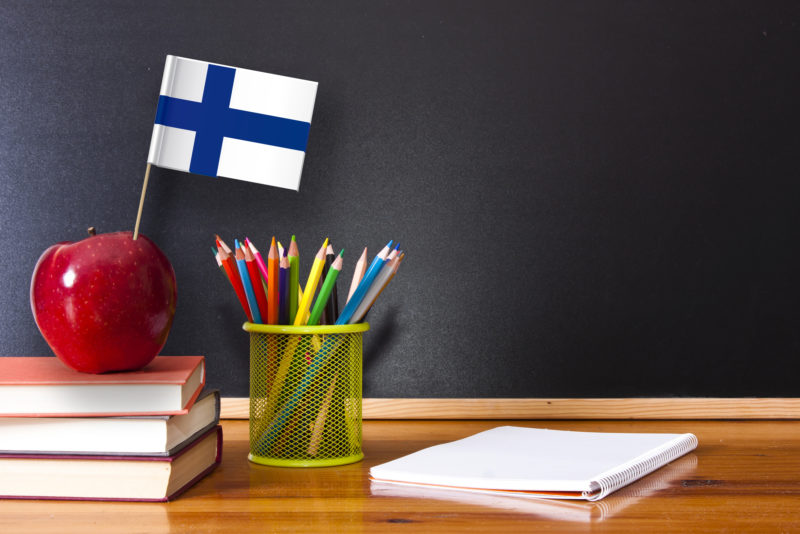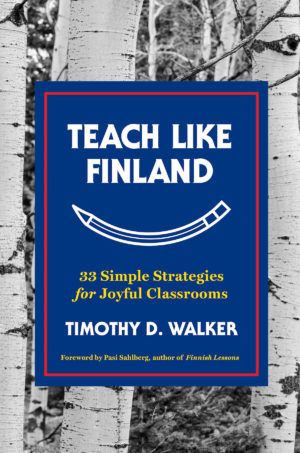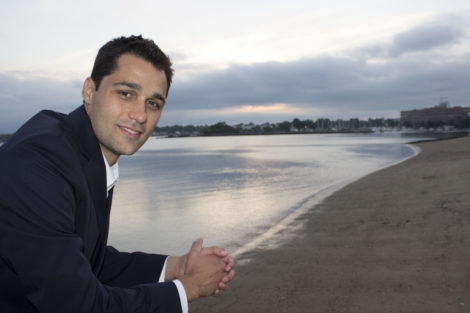 Like many other U.S. educators, Tim Walker* thought the schools in Finland sounded almost "mythical." The rejection of high-stakes testing, a curriculum based on critical thinking and problem-solving, smaller classes, the time reserved for collaboration between teachers - these are just few of the pillars of a system that has been heralded around the world. In 2013, Walker moved to Finland and was soon teaching fifth grade at a public school in Helsinki. He began documenting his experiences on his blog, Taught by Finland, and in a series of articles for The Atlantic. Being a teacher in Finland, Walker says, has "challenged my thinking about good teaching and learning," and, as it turns out, a lot of what works in a classroom in Helsinki can work in anywhere in the United States. In his just-released book, Teach Like Finland: 33 Simple Strategies for Joyful Classrooms, Walker offers U.S. educators a lively and practical guide on implementing Finland's best practices in their own classroom.
Like many other U.S. educators, Tim Walker* thought the schools in Finland sounded almost "mythical." The rejection of high-stakes testing, a curriculum based on critical thinking and problem-solving, smaller classes, the time reserved for collaboration between teachers - these are just few of the pillars of a system that has been heralded around the world. In 2013, Walker moved to Finland and was soon teaching fifth grade at a public school in Helsinki. He began documenting his experiences on his blog, Taught by Finland, and in a series of articles for The Atlantic. Being a teacher in Finland, Walker says, has "challenged my thinking about good teaching and learning," and, as it turns out, a lot of what works in a classroom in Helsinki can work in anywhere in the United States. In his just-released book, Teach Like Finland: 33 Simple Strategies for Joyful Classrooms, Walker offers U.S. educators a lively and practical guide on implementing Finland's best practices in their own classroom.
The discussion about the differences between Finland and the the U.S. is usually centered around major systemic differences, so what's unique and innovative about Finnish schools seems out-of-reach to most U.S. educators. Did you want your book to serve as a sort of a bridge that teachers can use to bring at least a little bit of Finland into their classrooms?
Timothy D. Walker: Yes, that is exactly what I’ve tried to do in my book! Most U.S. teachers encounter a much different teaching context than Finland’s educators. For several years, I’ve kept a blog about Finnish education where I’ve highlighted lessons I’ve learned in Finland, but I admit that I’ve rarely blogged about what American teachers could actually implement in their classrooms.
In "Teach Like Finland," I pushed myself to move beyond simply describing great practices in Finnish schools — I focused on suggesting strategies that can be easily wielded by U.S. teachers.
 While I agree that transplanting the entire Finnish model is unsuitable for America, I think it's misguided to think we need to have all or nothing. In my book, I’m focused on the little, practical things we can learn from Finland’s approach to education, in spite of the major differences.
While I agree that transplanting the entire Finnish model is unsuitable for America, I think it's misguided to think we need to have all or nothing. In my book, I’m focused on the little, practical things we can learn from Finland’s approach to education, in spite of the major differences.
When you live abroad, you encounter another culture. Your thinking is stretched and, naturally, you start reflecting on your own culture of origin. Something similar happened when I started teaching in Helsinki. I encountered a different school system. I began noticing subtle, sensible things that my Finnish colleagues were doing in their work. In short, they challenged my thinking about good teaching and learning.
What did you think about the strengths and weaknesses of American schools before you encountered the Finnish system?
TW: Before moving to Finland, I confess that I did very little thinking about how U.S. schools might compare to other schools around the world. I suspected that America had its share of “bad” schools, but I largely blamed the nation’s social inequality for their failings, not the educators. Also, I had a hunch that the world’s “best” schools could be found in the United States—institutions where children could encounter well-balanced curricula while learning in a student-centered manner with little stress.
Today I’m convinced, after teaching and living in Finland, that the glaring weakness in American education is, in fact, a basic matter of inaccessibility: too many kids in America lack access to decent schools.
If you had to pick one or two Finnish practices that American teachers would benefit most from adopting in their own classrooms, what would they be?
TW: I’d love to see American teachers adopt the practice of offering several short brain-breaks throughout the school day. Students in Finland can expect a 15-minute break for every 45 minutes of classroom instruction, and research shows that these kinds of breaks help students stay focused during class.
Taking a 15-minute break for every 45 minutes of classroom instruction like the Finnish do seems unimaginable to most American teachers.
TW: Many U.S. teachers would, undoubtedly, experience pushback from parents and administrators if they implemented a Finnish-style schedule, but I think it’s still possible to bring this research-backed strategy into the classroom while keeping things academic.
In "Teach Like Finland," I propose the idea of offering “choice time,” in which students have about 10 minutes to disconnect from the usual focused schoolwork several times each day. On these occasions, children can choose the engaging activities they want to pursue in the classroom, such as playing a fun math puzzler on their own or reading an interesting book at their independent reading level. Okay, it’s not free play, exactly, but choice time would provide students with several moments to get refreshed before the next lesson begins.
What are the lessons that Finnish teachers can learn from American teachers?
TW: Although Finland boasts a glowing reputation as an education superpower, it’s the United States, surprisingly, where many of the world’s most innovative pedagogies are conceived and developed. Pasi Sahlberg, the Helsinki-based scholar and the author of Finnish Lessons, identifies a number of these “borrowed” ideas in his book.
Finland’s newest core curriculum requires that teachers move away from subject-based, teacher-centered instruction toward interdisciplinary, student-centered teaching. Finnish educators, undoubtedly, would benefit from visiting American schools where project-based learning, an innovative interdisciplinary model, has been successfully implemented for years.
While many Finnish schools use an effective anti-bullying program called KiVa, I’d also like to see Finnish teachers emphasize social-emotional learning more systematically through implementing daily routines such as welcoming students with a handwritten note when they enter the classroom and offering a morning circle that builds a sense of community. I’ve found that many U.S. educators employ a social-emotional learning plan in their classrooms, and they rave about its importance.
It's frustrating that the Finnish "borrow" these ideas and showcase them to the world. We stand up and applaud - when many of them came from our own backyard. What does that say to you about the obstacles in the U.S. to implementing effective change in our schools?
 Tim Walker, author of "Teach Like Finland: 33 Simple Strategies for Joyful Classrooms" (Photo: David Popa)
Tim Walker, author of "Teach Like Finland: 33 Simple Strategies for Joyful Classrooms" (Photo: David Popa)
TW: Honestly, my respect for U.S. educators has only grown through teaching in Finland. American public school teachers often put up with so much - the long school days, test-based accountability, and so forth - and, yet, many remain committed to the profession in spite of the difficult working conditions. I’m convinced that the “system” is, ultimately, holding them back. There's a wealth of educational expertise and ideas in America, and US public school teachers need better working conditions to implement valuable changes.
What are the lessons that lawmakers and administrators in this country can take from Finland?
TW: Through teaching in Finland, I’ve understood that teacher time is an incredibly important issue. Here, teachers and students have a much lighter schedule compared to what I’m used to seeing in the United States. They enjoy short school days and several short breaks throughout the day; Finnish kids and educators seem much more fresh each day and the flexible schedule allowed for more collaboration among colleagues. In America, educators report the highest amount of classroom instruction per week, on average, compared to their international counterparts. Unlike Finland’s teachers, they also lack frequent breaks throughout the day. I’d like to see U.S. lawmakers and administrators take the issue of teacher time more seriously.
Teaching is definitely a respected profession in Finland, although I think that the status of teachers is sometimes exaggerated by outsiders. That said, when it comes to shaping national education reforms and school policies, Finland’s teachers have a seat at the table.
*Editor's Note: Just a coincidence - Tim Walker, author of "Teach Like Finland," and Tim Walker of NEA are two different people.





